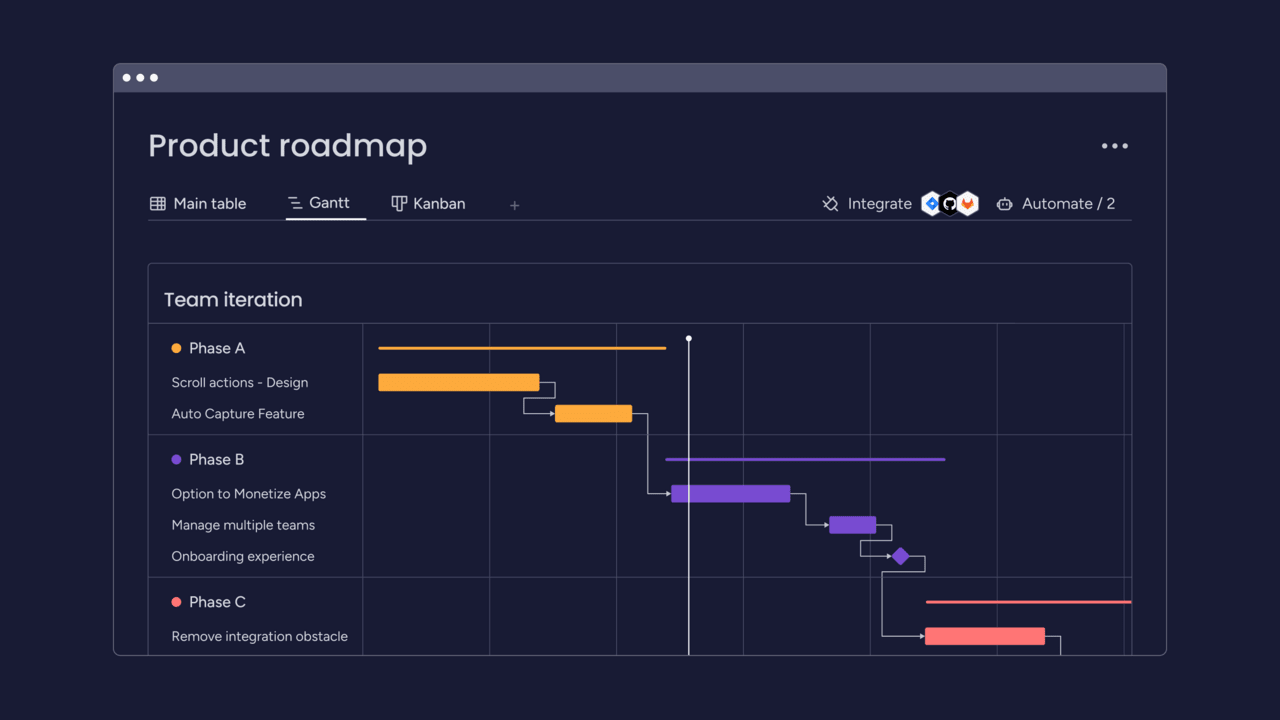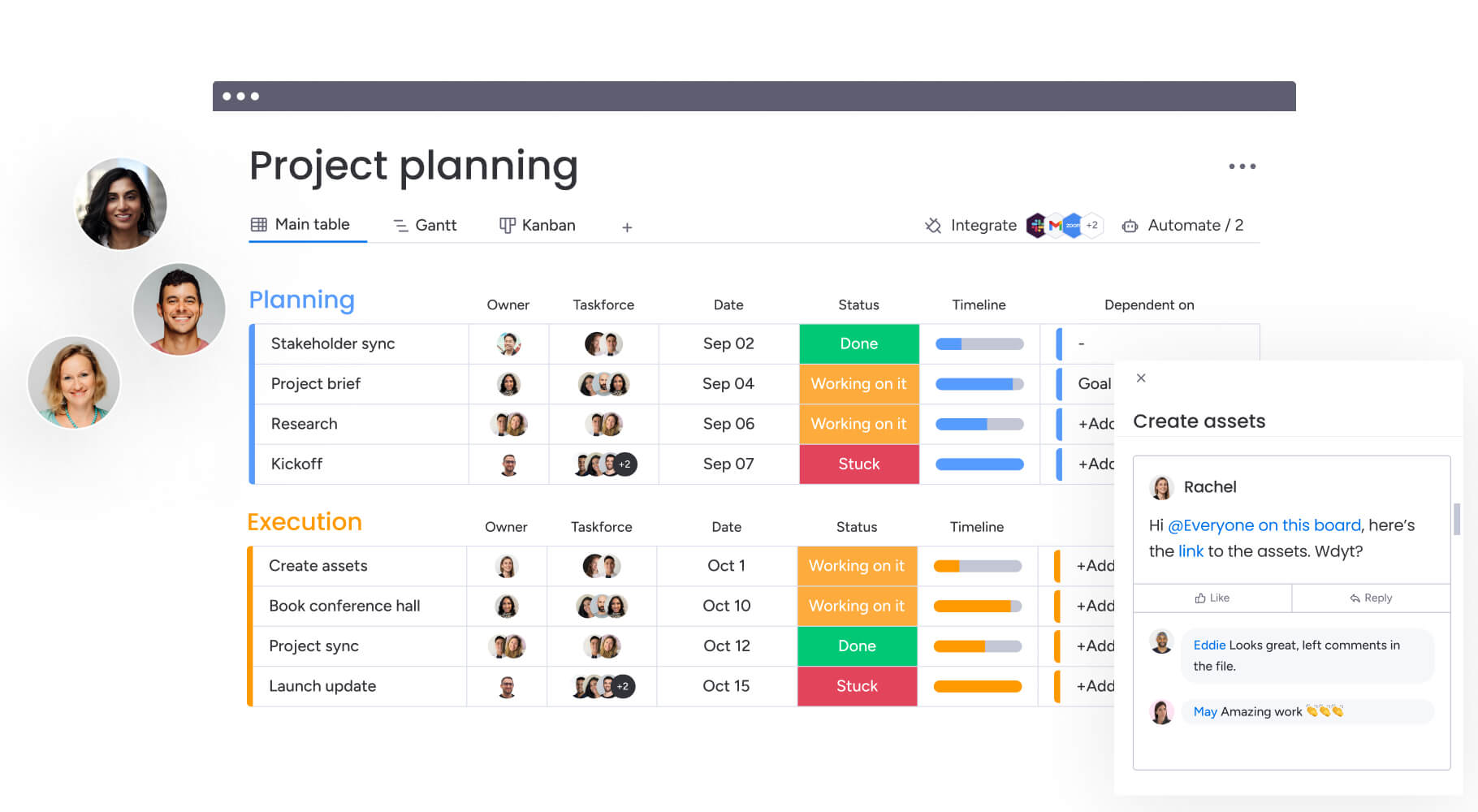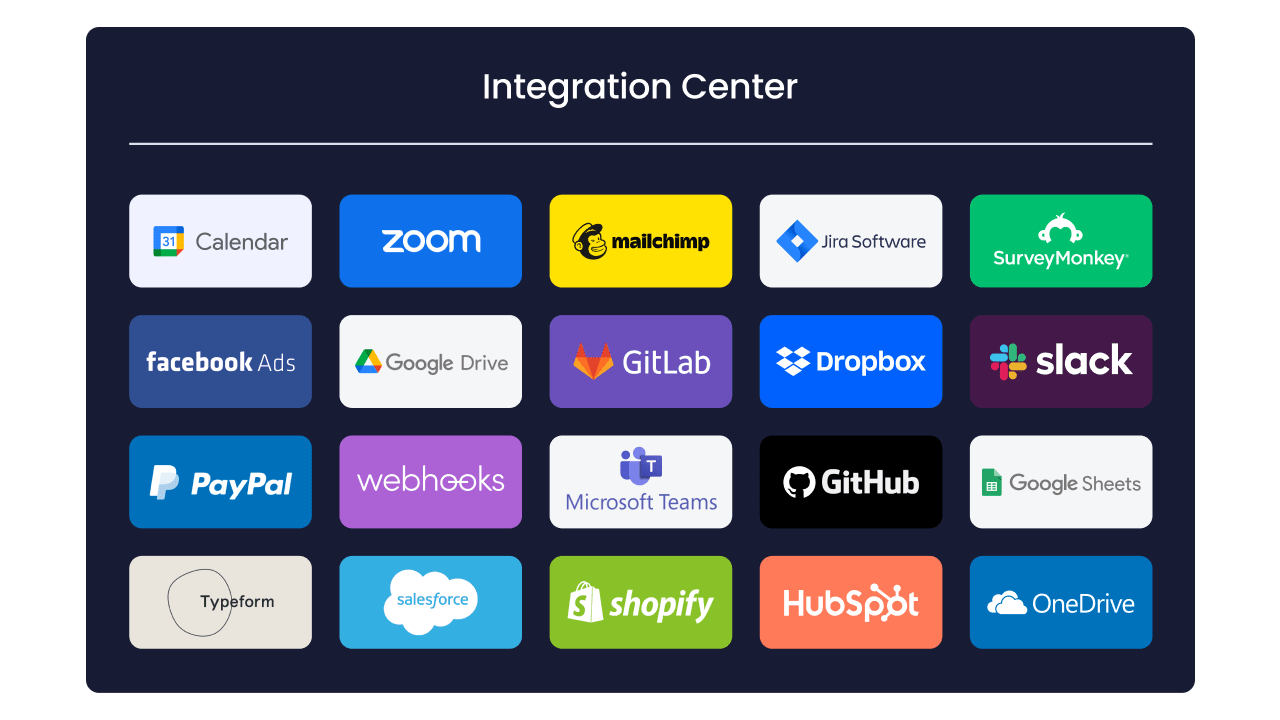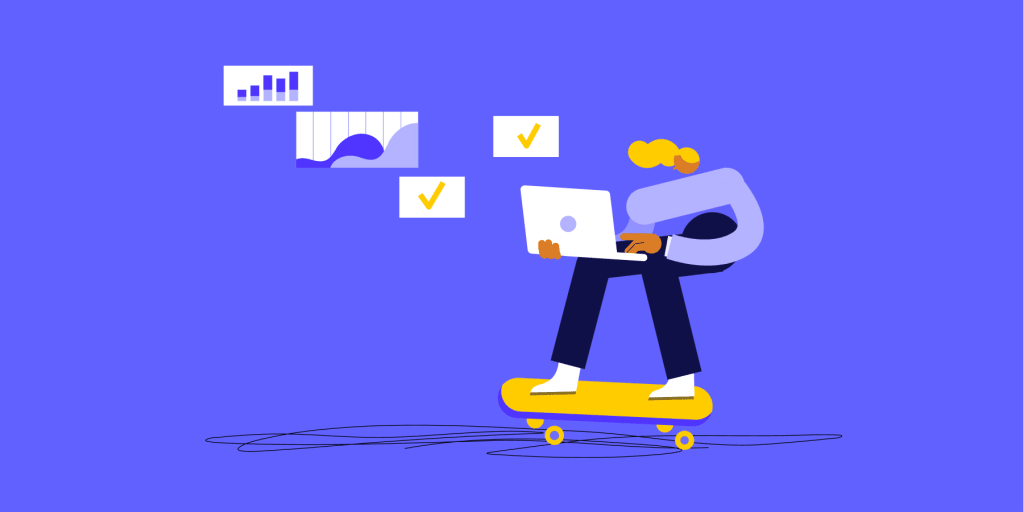Many organizations manage individual projects effectively but struggle to connect them to broader strategic goals. Research shows that nearly 60% experience a disconnect between day-to-day execution and long-term objectives, creating silos, duplicated efforts, and missed opportunities for growth.
Integrated project management bridges that gap by aligning every project, process, and team under a unified framework. It ensures that daily work supports strategic priorities, giving leaders the visibility to make confident decisions and teams the clarity to collaborate effectively.
When done well, this approach turns disconnected efforts into a cohesive strategy that moves the entire organization forward. It enables teams to anticipate challenges, allocate resources wisely, and measure success against meaningful outcomes.
Join us as we explore how integrated project management transforms scattered initiatives into streamlined execution — and why adopting this approach is becoming essential for organizations aiming to grow with focus, agility, and impact.
- Integrated project management: unifies all projects under one coordinated system, eliminating silos for faster delivery and stronger results.
- Modern approaches: optimize resources across the organization rather than managing them project by project.
- monday work management: provides the infrastructure for success with cross-departmental workflows, real-time dashboards, and AI insights that streamline complex initiatives.
- Effective implementation: relies on six core elements — unified charters, integrated scope management, collaborative planning, cross-functional execution, real-time monitoring, and coordinated change control
- Key benefits: include full portfolio visibility, optimized resource allocation, faster delivery timelines, and stronger alignment between projects and business objectives.
What is integrated project management?
Integrated project management is a methodology that unifies all project processes, teams, and resources under a single coordinated approach. This means your projects don’t operate in isolation, helping to avoid the issues that cause 78% of leaders to report ‘experiencing ‘collaboration drag’. Instead, they connect across departments and functions to create seamless execution from strategy to delivery.
It might be helpful to imagine the concept as the difference between managing a collection of separate projects versus orchestrating a symphony where every section plays in harmony. When you implement integrated project management, teams work from a unified source of truth with real-time visibility into dependencies, resource allocation, and progress across all connected projects.
The core components that make integrated project management work include:
- Unified approach: connects all project elements from planning to execution.
- Cross-functional coordination: breaks down silos between departments.
- Single source of truth: centralizes project information and decision-making
- End-to-end visibility: provides complete oversight of project portfolios.
Why use integrated project management over traditional approaches?
Traditional project management creates invisible barriers that slow execution. When projects operate in isolation, you miss opportunities for resource optimization and face delays from poor coordination between teams.
Integrated project management solves these challenges by creating strategic alignment from day one. Every project connects to organizational goals, and teams understand how their work drives broader outcomes, reflecting strong portfolio management practices.
What makes integrated project management particularly valuable for executives? It delivers measurable business impact through:
- Strategic alignment: all projects support organizational goals rather than competing for resources.
- Resource optimization: eliminates duplicate efforts and conflicting priorities.
- Risk mitigation: surfaces dependencies and potential conflicts early.
- Accelerated delivery: reduces handoff delays through coordinated workflows.
- Stakeholder satisfaction: improves communication and transparency at every level
It’s worth noting at this point that modern work management platforms like monday work management can help enable integration projects by connecting workflows, automating handoffs, and providing real-time visibility across all project activities.
Integrated project management vs traditional project management: key differences
The main difference lies in focus and coordination. Traditional methods center on completing individual projects, while integrated approaches align multiple initiatives toward shared business goals.
Much like program management vs project management, the emphasis shifts from managing tasks in isolation to connecting work across departments for greater organizational impact.
As operations grow more complex, this integrated approach becomes essential for visibility, resource optimization, and strategic alignment — the foundation of effective enterprise project management.
The table below outlines how the two approaches compare across key areas such as communication, scope, and decision-making.
| Aspect | Traditional project management | Integrated project management |
|---|---|---|
| Scope | Individual projects | Portfolio-wide coordination |
| Communication | Department-specific | Cross-functional transparency |
| Resource allocation | Project-by-project | Organization-wide optimization |
| Decision making | Isolated project teams | Unified leadership approach |
| Risk management | Project-level only | Enterprise-wide visibility |
6 key components of integrated project management systems
An integrated approach to project management depends on structure, visibility, and collaboration. To keep multiple initiatives aligned, organizations need systems that connect goals, resources, and progress across every level of work.
These six components form the foundation of a strong integrated project management system. Together, they ensure that every project contributes to the same strategic direction while maintaining coordination, transparency, and control throughout execution.
Project charter development
Integrated project charters connect individual project goals to organizational strategy and related initiatives. These charters document not just what you’ll accomplish, but how it supports broader business objectives.
The charter identifies all stakeholders across departments and establishes shared success criteria. This upfront alignment prevents scope conflicts and resource competition later.
Unified project scope management
Scope management in integrated systems maintains visibility across all related projects. Rather than managing scope in isolation, you consider how changes in one project impact others.
This includes regular scope reviews across portfolios and coordinated approval processes. When scope changes are necessary, the integrated approach ensures all affected projects stay informed and aligned.
Integrated management planning
Planning becomes collaborative across departments. Cross-functional planning sessions bring together stakeholders to create coordinated timelines and resource allocations, forming an integrated master plan that ensures alignment.
This process identifies dependencies early and prevents resource conflicts. Teams use shared planning platforms to maintain visibility throughout execution.
Cross-functional execution framework
Execution involves ongoing collaboration with shared accountability and transparent progress tracking. Teams maintain continuous coordination rather than just handing work off between departments.
The framework includes regular check-ins, shared progress tracking, and coordinated problem-solving. This ensures execution stays aligned with integrated plans and accommodates specific needs like IT project management.
Real-time monitoring and control
Integrated systems function as a comprehensive project management information system, giving teams live visibility into performance across all projects. Unified dashboards and real-time reporting show how each initiative influences others and how external changes affect overall timelines.
This level of visibility enables proactive decision-making. When challenges arise, teams can quickly assess the broader impact, coordinate responses, and keep every project aligned with organizational objectives.
Integrated change control process
Changes in one project automatically trigger assessments across all related areas. This ensures modifications are evaluated for their full organizational impact.
The process includes impact assessment, coordinated approvals, and systematic communication to all affected stakeholders. This prevents unintended consequences across your project portfolio.

7 steps to successfully implement integrated project management
Implementing integrated project management ‘requires a systematic approach’ to bridge the gap between how leadership and employees perceive organizational change. These seven steps provide a practical framework for transitioning while maintaining project momentum.
Step 1: develop your integrated project charter
Create charters that connect to organizational strategy and identify all cross-functional stakeholders. Document how the project supports business objectives and which initiatives it connects to.
Include stakeholder mapping beyond the immediate project team. This comprehensive identification ensures integration planning begins with complete visibility.
Step 2: build your integrated management plan
Account for cross-project dependencies and resource sharing. Bring together representatives from all affected areas to identify conflicts and establish coordinated timelines.
Use collaborative sessions to surface hidden dependencies. Document these clearly and establish management processes for the project lifecycle, ensuring strong project governance throughout.
Step 3: align and direct cross-functional project work
Effective coordination depends on clear communication and shared accountability. Establish frameworks that keep every team connected and moving toward the same objectives:
- Set communication protocols: schedule regular check-ins, define escalation paths, and use shared tracking systems to maintain alignment.
- Clarify decision-making frameworks: ensure teams understand how cross-functional decisions are made and who holds final authority.
- Define cross-functional roles: outline responsibilities that extend beyond departmental boundaries so every contributor knows their role in both individual and integrated outcomes.
This structure ensures collaboration remains consistent, transparent, and focused on collective success.
Step 4: create knowledge management systems
Capture and share project knowledge to prevent information silos. Focus on insights that benefit multiple projects and departments.
Document lessons learned and best practices in accessible ways. Teams can also benefit from a project management glossary to clarify terminology and enhance organizational learning over time.
Step 5: monitor performance across all projects
Maintaining visibility across an entire portfolio is essential for keeping projects aligned and on track. Go beyond individual dashboards to create integrated views that reveal cross-project trends, dependencies, and resource utilization.
Automated reporting helps surface risks and bottlenecks early, allowing teams to act before small issues escalate. A connected platform like monday work management brings these insights together in one place, making it easier to track performance, share updates, and keep every initiative moving in sync.
Step 6: manage changes through integrated control
Handle changes affecting multiple projects simultaneously. Include impact assessments, coordinated approvals, and systematic communication.
Evaluate both direct and indirect effects on related projects and organizational objectives.
Step 7: execute integrated project closure
Capture lessons learned and benefits for the entire organization. Document insights that improve future integration efforts.
Evaluate how well the integration approach worked and identify improvement opportunities.
The evolving role of an integrated project manager
In an integrated environment, the role of the project manager extends beyond overseeing individual initiatives to coordinating complex, cross-functional efforts. These leaders act as orchestrators, ensuring that multiple projects move in harmony toward shared strategic goals.
This expanded responsibility demands a broader perspective — one that considers how each project interacts with organizational objectives and parallel initiatives. Success relies on applying core project management principles to drive alignment, collaboration, and measurable results across the entire portfolio.
Leading cross-functional integration
Integrated project managers coordinate across departments with different priorities and working styles. This requires diplomatic skills for conflict resolution and negotiation abilities for resource optimization.
Success depends on building trust and credibility across organizational boundaries. You need to facilitate collaboration between teams that may have competing metrics.
Managing stakeholders across departments
Coordinating across departments means balancing different goals, timelines, and priorities. Effective stakeholder management ensures every group stays aligned and informed.
- Understand departmental dynamics: learn how each team operates and what success looks like for them.
- Tailor communication strategies: adapt messaging for different audiences to maintain engagement and clarity.
- Facilitate collaborative decisions: create processes that account for cross-departmental impacts before moving forward.
This structured approach builds alignment, minimizes friction, and fosters stronger collaboration across the organization.
Driving process alignment and optimization
Integrated project managers play a key role in improving how teams work together across departments. The focus is on identifying inefficiencies and turning insights into coordinated improvements.
- Analyze workflows: pinpoint gaps or redundancies that slow down collaboration.
- Streamline processes: simplify complex handoffs and improve coordination between teams.
- Lead change initiatives: apply creative thinking and strong change management to implement improvements effectively.
These efforts create smoother operations, clearer accountability, and better performance across the organization.

5 game-changing benefits of integrated project management
Integrated project management turns coordination into a competitive advantage. By connecting projects, teams, and strategies, organizations move faster, make better decisions, and achieve measurable impact.
These five benefits show how integration transforms project execution into a unified system that drives efficiency, visibility, and strategic alignment across the entire business.
Break down organizational silos
Integration creates shared visibility and accountability across departments. Teams understand how their work connects to organizational objectives and other initiatives.
This leads to improved decision-making, reduced duplication, and stronger alignment between different organizational parts.
Gain complete portfolio visibility
See all projects and interdependencies in one view for informed decisions about resources and priorities. This visibility prevents surprises and enables proactive capacity management.
Portfolio visibility improves forecasting as leaders see how scenarios impact the entire portfolio.
Maximize resource utilization
Prevent conflicts and optimize allocation by providing visibility into capacity and demand. Identify opportunities for sharing resources and coordinating timelines.
Make strategic decisions about where to focus organizational capacity for maximum impact.
Accelerate project delivery
Coordination reduces delays by establishing collaboration processes. When teams work together from the beginning, overall timelines improve significantly.
Acceleration comes from improved coordination preventing conflicts, constraints, and communication gaps.
Achieve strategic business alignment
Ensure all work supports objectives by creating explicit connections between projects and goals. This prevents successful projects that don’t contribute to business success.
Strategic alignment improves resource decisions as leaders prioritize based on organizational contribution.
Future of integrated project management: emerging trends
As organizations take on more complex portfolios, integrated project management continues to evolve. The next wave of innovation is driven by technology, flexibility, and data-driven visibility — reshaping how teams plan, collaborate, and deliver results.
From AI-powered automation to hybrid methodologies and advanced visualization tools, these trends show how integration is moving beyond coordination to create smarter, faster, and more connected ways of working.
AI and automation in project integration
Artificial intelligence provides predictive insights and automates coordination tasks, a trend reflecting its widespread adoption across industries, with over half of project professionals using it in up to 50% of their projects. The AI capabilities in monday work management, for example, offer intelligent work assignment and resource optimization.
Hybrid IPM methodologies
Modern organizations are blending multiple approaches within integrated frameworks to suit different types of work. Agile methods may drive development projects, while traditional techniques ensure structure and compliance where needed.
By exploring various project management methodologies, teams can choose the best fit for each initiative. This flexibility enhances adoption, boosts effectiveness across departments, and preserves the core benefits of integration.
Advanced visual management dashboards
Visual management provides intuitive, real-time views of status and dependencies. These dashboards make complex relationships easier to understand.
Advanced visualization includes interactive mapping and predictive modelling helping teams understand change impacts.
Automated cross-platform workflows
Automation eliminates manual handoffs ensuring information flows between platforms. This reduces errors and accelerates timelines.
Cross-platform automation includes status updates, task routing, and synchronized allocation across systems.

Scale your integrated project management with monday work management
Successfully managing integration across multiple teams, departments, and initiatives requires more than coordination. It calls for a connected platform that unites projects, streamlines communication, and provides visibility into how every effort supports strategic goals.
With its flexible Work OS, monday work management gives organizations the structure to coordinate complex initiatives, automate repetitive tasks, and gain real-time insights that keep projects aligned from start to finish.
The following capabilities show how the platform supports integrated project management at scale:
Cross-departmental workflow creation
Connect teams seamlessly across organizational boundaries with customizable workflows that eliminate silos. Design end-to-end processes that maintain visibility throughout the project lifecycle.
- Create multi-department approval flows with automated handoffs.
- Configure conditional workflows based on project parameters.
- Maintain complete visibility into cross-functional activities.
Advanced automations for seamless coordination
Reduce manual coordination effort with powerful automations that keep work flowing across teams. Let the platform handle routine updates while your teams focus on high-value activities.
- Trigger notifications based on status changes.
- Automate approval routing across departments.
- Schedule recurring tasks and updates without manual intervention.
200+ integrations for connected systems
Unify your tech stack with native integrations that prevent information silos. Connect the tools your teams already use to create a seamless integrated experience.
- Sync data with CRM, ERP, and financial systems.
- Connect design, development, and marketing platforms.
- Maintain consistency across all project documentation.
Powerful AI features for predictive insights
Leverage AI capabilities to identify potential issues before they impact timelines. Get recommendations that help maintain performance across complex project portfolios.
- Receive AI-generated suggestions for resource optimization.
- Identify risk patterns across similar projects.
- Generate status reports and summaries automatically.
Real-time visibility across integrated projects
Make confident decisions with comprehensive dashboards showing status, utilization, and strategic alignment. Surface potential issues early for proactive management across portfolios.
- View cross-project dependencies in interactive visualizations.
- Monitor resource allocation across all integrated initiatives.
- Track progress toward strategic objectives in real time.

Frequently asked questions
What is the difference between project management and integrated project management?
The difference between project management and integrated project management is that traditional project management focuses on individual projects while integrated project management coordinates multiple interconnected projects across an organization to achieve strategic objectives.
How does integrated project management improve team collaboration?
Integrated project management improves team collaboration by breaking down departmental barriers and creating shared visibility into goals, timelines, and dependencies so teams work from a unified source of truth.
Can small businesses benefit from integrated project management?
Small businesses can benefit from integrated project management as they grow and take on complex projects with interdependencies since the methodology scales to organizational size without adding unnecessary overhead.
What platforms support integrated project management systems?
Platforms that support integrated project management systems— like monday work management— bring together cross-functional workflows, real-time portfolio visibility, automated coordination, and advanced reporting enhanced by AI-driven insights.
How do you measure integrated project management success?
You measure integrated project management success through portfolio-level metrics including strategic objective achievement, resource utilization optimization, and cross-project coordination effectiveness within broader organizational outcomes.
Does integrated project management work with agile methodologies?
Integrated project management works with agile methodologies by providing coordination frameworks aligning multiple agile teams toward common objectives while ensuring sprint outcomes contribute to organizational goals.
